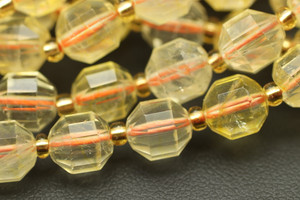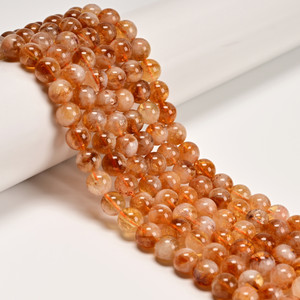
Citrine, Quartz, AB Coated, Heated, Faceted Round, One 8mm Strand
Beauty in the BeadCitrine, Quartz, AB Coated, Heated, Faceted Round, One 8mm Strand
This price is for one strand 15 to 16 inches long
8mm strands have about 45 pieces
Quartz is a hard, crystalline mineral composed of silicon and oxygen atoms. Quartz is the second most abundant mineral in Earth's continental crust, behind feldspar.
Citrine is a transparent, yellow variety of Quartz, ranging in color from pale to golden yellow, honey or almost brown, and may contain rainbow or sparkle inclusions. Naturally, it takes its color from the traces of iron in the quartz and the heat from nearby magmatic bodies. The only difference between Citrine and Lemon Quartz is in the saturation and tone of their color. Many gem dealers do not even separate the two and use the name Citrine for all Yellow or Lemon Quartz. The name comes from the French word citron, meaning lemon.
Natural yellow Citrine is rare and often cut as gemstones, not beads. What is left is mostly are a pale yellow. Much of the natural Citrine may have started out as Amethyst but heat from nearby magmatic bodies may have caused the change to Citrine. Most Citrine on the market is heat-treated Amethyst or Smoky Quartz.
From the earliest of times, Citrine was called the "sun stone" and the gemstone was thought capable of holding sunlight. Citrine comes from Brazil, Madagascar, Russia, Spain, France, and Scotland. This stone is also found in Colorado.
Hardness 7
These beads are cut, drilled and polished in China.
Heating is a very common form of enhancement and is used to affect desired alterations of color and/or clarity. Heating can also be used to lighten or darken a stone. Heat is one of the conditions that cause gems to form, whether in the ground or in a lab. Heating occurs during natural gem formation. But heating applied to the stone after gem formation is an enhancement.
AB Coating on beads stands for "Aurora Borealis" which is an iridescent coating applied to beads that creates a shimmering rainbow-like effect. When light hits it has a similar appearance to the Northern Lights. This coating gives the beads a multi-colored, reflective quality depending on the viewing angle and light. AB Coating was invented in 1955 by Swarovski in partnership with Christian Dior.








